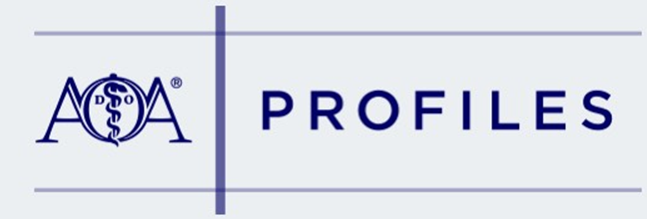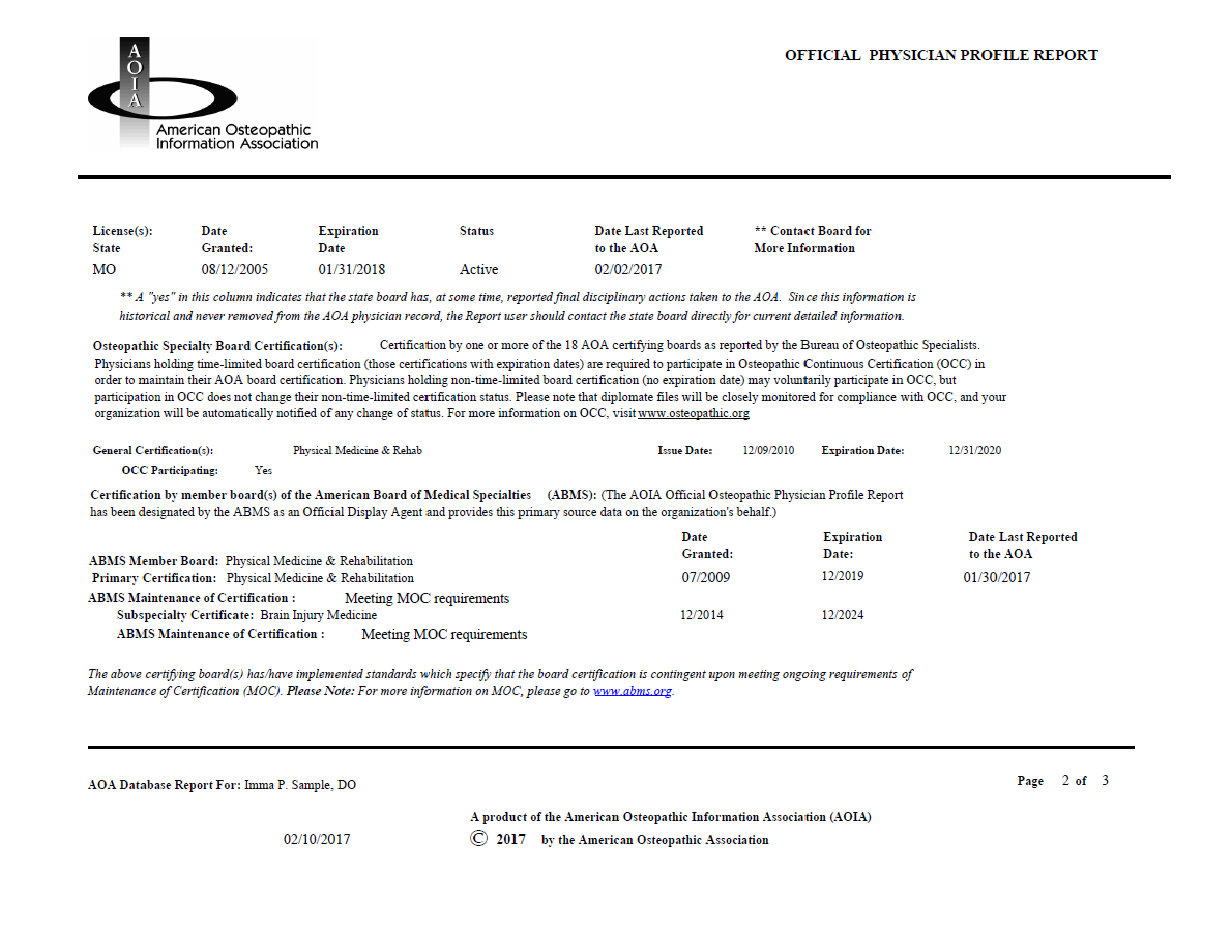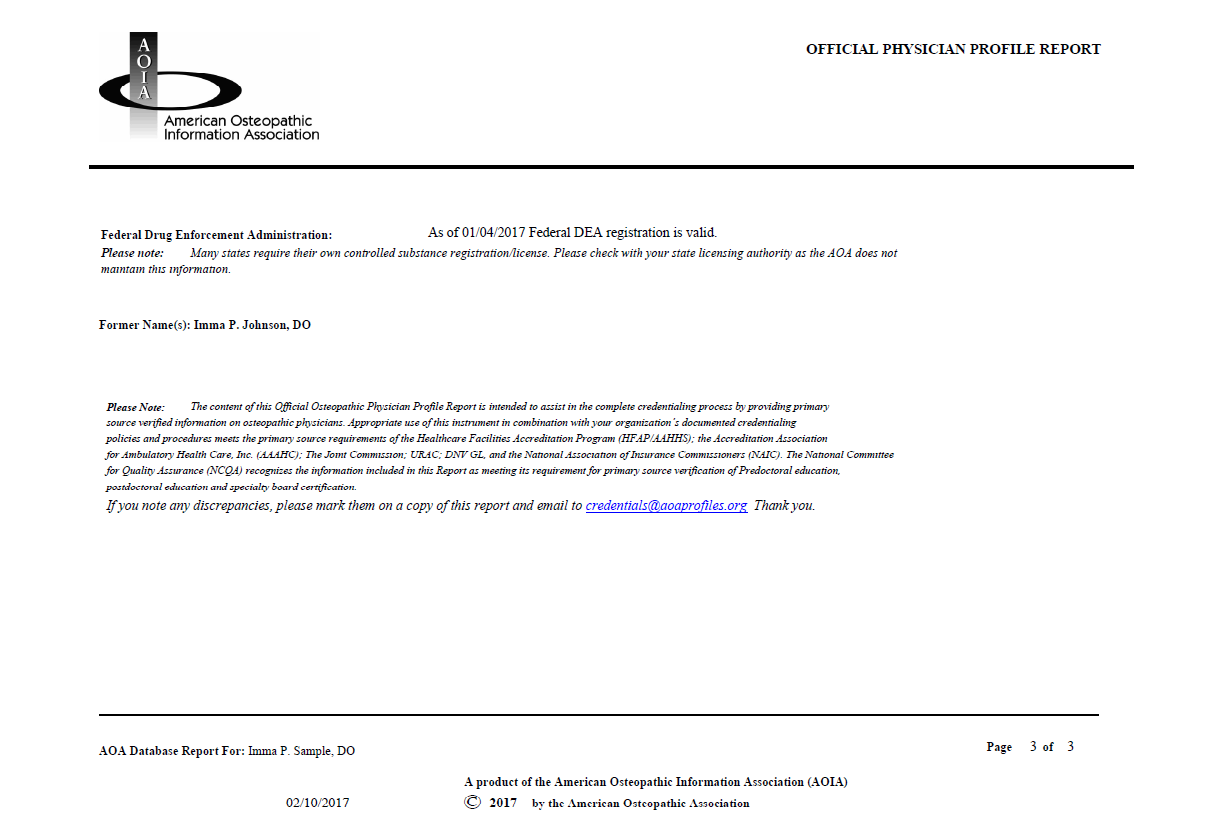

REPORT CONTENTS
The Official Physician Profile Report features comprehensive, up-to-date, primary-source information from the AOA. The report includes the following:
Official Physician Profile Reports are only valid if they are sent directly from the AOIA to the state licensing board or are ordered online for credential verification purposes. Unofficial copies are not sufficient as primary source verification for state licensing or credential verification purposes.
A detailed description of these data elements is below the sample profile.
PRIMARY SOURCE AUTHORITY
The Report, used in combination with established credentialing procedures, meets certain primary source requirements for osteopathic medical education, osteopathic postdoctoral training and osteopathic specialty board certification for the following accrediting agencies: the AOA Healthcare Facilities Accreditation Program; TJC; NCQA; URAC; and the NAIC.



DETAILED DESCRIPTION OF DATA ELEMENTS
Official Physician Profile Reports of all doctors of osteopathic medicine (over 100,000) are generated from the American Osteopathic Association's physician database.
1. Name
When a database record is initially created, the current name that the student uses is listed. Throughout the physician's career, all name changes are strictly verified before the record is updated. All former names are maintained and reported in the "historical biographical information" section.
2. Address
The address listed is the physician's "preferred address" as reported to the AOA on the ongoing Census and in ongoing contact with the physician. Other sources of addresses are mailings and publications, physician correspondence and correspondence from all primary sources. Former addresses and all addresses submitted by state licensing boards are maintained for tracking purposes.
3. Phone Number
The physician supplies the phone number listed to the AOA. Phone numbers are not changed unless the physician informs the AOA of a change, usually during the membership renewal cycle in the spring.
4. Birth date
Birth dates are obtained directly from the AOA-accredited colleges of osteopathic medicine and are added when the database record is initially created. Any changes to the birth date must be supported by official documentation, such as a birth certificate, passport or visa.
5. Self-designated Practice Focus
The physician reports practice focus (sometimes referred to as "specialty") to the AOA through the ongoing census. This is a self-designated item. The fact that a physician chooses to designate a given practice focus does not necessarily mean that the physician has been trained or has special expertise in that area.
6. AOA Membership Status
Indicates whether a physician is a member of the AOA for the current membership year.
7. Predoctoral Education
Colleges of Osteopathic Medicine accredited by the AOA Commission on Osteopathic College Accreditation (AOA COCA) send the AOA rosters of all their students annually. A pre-graduation report is submitted annually for each graduating class and then a graduation verification report is sent. Other schools attended (e.g. undergraduate, graduate schools not related to osteopathic medicine, etc.) are not listed.
8. Postdoctoral Education
All osteopathic internship and residency programs approved by the AOA Council on Postdoctoral Training must submit all information on interns and residents directly to the AOA Department of Education. All information is captured, including those residency segments that the physician signs a contract for and does not enter, as well as those segments started but not completed. Postdoctoral education contracts may change throughout the year. As they do, the database is updated. The Official Osteopathic Physician Profile Report includes all AOA-approved postdoctoral segments and indicates verified dates attended. If the physician did not successfully complete the training segment, that information is noted on the report. Postdoctoral Training completed in programs accredited by the Accrediting Council Graduate Medical Education (ACGME) submitted to and approved by the AOA Council on Postdoctoral Training are also listed in this section as "AOA-approved." (AOA-approved ACGME-accredited PGY1 programs are listed as "residencies" rather than "internships." If approved by the AOA, the PGY1 segment is found to be equivalent to the traditional osteopathic rotating internship.)
Some osteopathic physicians enter allopathic residency training programs and do not request approval by the AOA Council on Postdoctoral Training. This information is not routinely tracked. At the request of physicians, the AOA will add those training segments to the record only after contacting the directors of training programs accredited by the Accreditation Council for Graduate Medical Education (ACGME) to obtain primary source verification of completion. Once obtained, the segment is labeled "verified." The AOA asks that you contact the program directors on all ACGME segments that do not appear on the report.
9. State Licensure
Historically, the AOA has collected medical licensure information from state licensing authorities for the database. Every medical license held by the physician is recorded in the database and updated at least quarterly with the state boards. All licenses ever held are maintained on the database and reported. The Report lists the state, date granted (if reported by the state), expiration date (if reported by the state), status (active or inactive) and the date last reported to the AOA by the state.
All state medical and osteopathic boards regularly report final disciplinary actions taken to the AOA. The AOA does not attempt to summarize these reports, but flags the physician's record. If the AOA is aware that such a report exists, the user is instructed to contact the specific state board for more information.
10. Osteopathic Specialty Board Certification
The AOA Bureau of Osteopathic Specialists reports all certifications by one or more of their 18 specialty boards to the AOA. The Report lists all such certifications, the date of certification or recertification and, if applicable, the expiration date. Note: Some osteopathic physicians with lifetime certificates that do not expire, may choose to recertify. However, this is optional and the original certification does not expire.
Osteopathic Continuous Certification (OCC) is required for all osteopathic physicians holding time-limited certificates (those certifications with expiration dates). Physicians holding non-time-limited board certification (no expiration date) may voluntarily participate in OCC, but participation does not change their non-time-limited certification status. For more information on OCC, visit www.osteopathic.org. Whether or not a physician is participating in OCC is indicated on the Profile.
11. Certification by member board(s) of the American Board of Medical Specialties® (ABMS®)
Some osteopathic physicians hold specialty board certification from one or more of the 24 member boards of the American Board of Medical Specialties. The Report lists all such certifications, the date of certification or recertification and, if applicable, the expiration date. The AOIA Official Osteopathic Physician Profile Report has been designated by the ABMS® as an Official Display Agent and provides this primary source data on their behalf.
The 24 Boards of the ABMS® have implemented standards which specify that the board certification is contingent upon meeting ongoing requirements of Maintenance of Certification (MOC). Whether or not a physician is participating and/or required to participate in MOC is listed on the AOIA Official Osteopathic Physician Profile Report.
12. DEA Registration
The AOA obtains the monthly CD-ROM from the National Technical Information Service (NTIS) and matches the current DEA registration information to the physician database. For security purposes, the DEA number and the approved schedules do not appear on the Report. The Report lists only "as of day/month/year federal DEA license is valid" or "none reported."